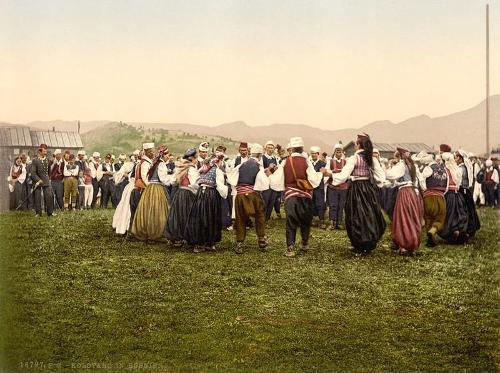BOSNIA AND HERZEGOVINA
Population

Population
Cities in BOSNIA AND HERZEGOVINA
| Sarajevo |
Population
Composition and distribution
 Bosnian Folk DancesPhoto:Snapshots Of The Past CC2.0 Generic no changes made
Bosnian Folk DancesPhoto:Snapshots Of The Past CC2.0 Generic no changes made
Before the 1992-1995 civil war, 44% of the population was Bosnian Muslims (now Bosnjaks), 31% Serbs, 17% Croats, 6% 'Yugoslavs' and the remaining 2% Montenegrins, Roma, Albanians and Ukrainians. Today, the distribution is roughly: 50% Bosniacs (the religion-neutral name of the group previously classified as Muslims), 31% Serbs, 15% Croats and 4% others.
Before the war, the different population groups lived all over the country and there were many mixed neighborhoods, especially in the larger cities. Today the country is highly segregated: the Bosjaks live mainly in the northwest and in the center, the Croats in the west, the far northeast and in the center, the Serbs in the north and the east.
The Roma (formerly called Gypsies) have lived in Bosnia-Herzegovina since the 14th century. With several tens of thousands of people, they are the largest minority in the country.
In 1941 most of the Jewish community was deported and murdered. At the moment there are between 500-1000 Jews living in Bosnia.
It is estimated that as a result of the violence of war and the policy of ethnic cleansing during the war, approximately 60% of the population of that time was expelled from home and home. More than 250,000 refugees have been killed or are missing. Approx. 1.3 million people fled within Bosnia and Herzegovina and 1.2 people fled abroad.
After the war, many returned, but encountered new difficulties. Refugees returning to places dominated by their ethnic communities had the least problem. However, people returning to areas that had changed ethnic majority through the war were now in the minority there. These people also had little to expect from the government.
Young families with small children moved en masse from the countryside to the city. From the signing of the Dayton Agreement to the end of February 2002, 834,000 displaced persons and refugees have returned. It is estimated that approximately 700,000 displaced persons will never return to Bosnia and Herzegovina.
Many families are incomplete because the husband has died; women and children are often severely traumatized. Help for these people is inadequate.
Demographic data
In Bosnia-Herzegovina, there were 3,5 million people in 2024. The population density is approximately 70 inhabitants per km2.
- Population growth was -0.25% in 2024.
- The average life expectancy is 75.5 years for men and 81.6 years for women.
- Population composition: 0-14 years 13.1%, 15-64 years 68.3%, 65+ 18.6%. (2024)
- Bosnia and Herzegovina has a birth rate of 8.2 births per 1000 inhabitants and a death rate of 10,3 per 1000 inhabitants. (2024)
Sources
Campschreur, W. / Bosnië-Herzegovina : mensen, politiek, economie, cultuur, milieu
Koninklijk Instituut voor de Tropen : Novib
Gabrielpillai, M. / Bosnia and Herzegovina
Gareth Stevens Publishing
Milivojevic, J. / Bosnia and Herzegovina
Children’s Press
Phillips, D. / Bosnia and Herzegovina
Chelsea House Publishers
CIA - World Factbook
BBC - Country Profiles
Copyright: Team The World of Info